5 Complex Numbers
We have seen that \(\sqrt{x}\) exists in \(\mathbb{R}\) for all for \(x \geq 0\). We defined \[ \sqrt{x}:= \alpha \,, \quad \alpha := \sup \{ t \in \mathbb{R}\, \colon \,t^2 < x \}\,, \] and proved that \[ \alpha^2 = x \,. \] This procedure was possible for \(x \geq 0\).
Question 1
The answer to the above question is no. This is because \(\mathbb{R}\) is an ordered field, and from axiom (MO) it follows that: \[ x^2 \geq 0 \,, \quad \forall \, x \in \mathbb{R}\,. \] However we would still like to solve equation (5.1) somehow. To do this, we introduce the imaginary numbers or complex numbers. We define \(i\) to be that number such that \[ i^{2}=-1 \,. \] Formally, we can also think of \(i=\sqrt{-1}\). We can use this speacial number to define the square root of a negative number \(x<0\): \[ \sqrt{x}: = i \sqrt{-x} \,. \] Note that \(\sqrt{-x}\) is properly defined in \(\mathbb{R}\), because \(-x>0\) if \(x<0\).
5.1 The field \(\mathbb{C}\)
We would like to be able to do calculations with the newly introduced complex numbers, and investigate their properties. We can introduce them rigorously as a field, as we did for \(\mathbb{R}\).
Definition 2: Complex Numbers
\[ \mathbb{C}:= \mathbb{R}\oplus i \mathbb{R}:= \{x \oplus i y \, \colon \,x, y \in \mathbb{R}\} \,. \]
In the above the symbol \(\oplus\) is used to denote the pair \[ x \oplus i y = (x,y) \] with \(x,y \in \mathbb{R}\). This means that \(x\) and \(y\) play different roles.
Definition 3
For a complex number \[ z = x \oplus i y \in \mathbb{C} \] we say that
- \(x\) is the real part of \(z\), and denote it by \[ x = \operatorname{Re}(z) \]
- \(y\) is the imaginary part of \(z\), and denote it by \[ y = \operatorname{Im}(z) \]
We say that
- If \(\operatorname{Re}z = 0\) then \(z\) is a purely imaginary number.
- If \(\operatorname{Im}z = 0\) then \(z\) is a real number.
In order to make the set \(\mathbb{C}\) into a field, we first have to define the two binary operations of addition \(+\) and multiplication \(\cdot\), \[ + , \cdot \,\, \colon \mathbb{C}\times \mathbb{C}\to \mathbb{C}\,. \] Then we need to prove that these operations satisfy all the field axioms.
Definition 4: Addition in \(\mathbb{C}\)
Clearly, \(z_1 + z_2\) as defined above is an element of \(\mathbb{C}\). Therefore \(+\) defines a binary operation over \(\mathbb{C}\).
Notation 5
\[ (x \oplus i 0 )+(0 \oplus i y)= x \oplus i y . \] To simplify notation, we will write \[ x \oplus i 0 = x \,, \quad \, 0 \oplus i y = i y \] and \[ x \oplus i y = x + i y \,. \] We will also often swap \(i\) and \(y\), writing equivalently \[ x + i y = x + y i \,. \]
We now want to define multiplication between complex numbers.
Remark 6: Formal calculation for multiplication in \(\mathbb{C}\)
\[\begin{align*} z_1 \cdot z_2 & = \left(x_{1}+i y_{1} \right) \cdot \left(x_{2}+ i y_{2} \right) \\ & = x_{1} \cdot x_{2} + x_{1} \cdot i y_{2} + x_{2} \cdot i y_{1} + y_{1} \cdot i^2 y_{2} \\ & = \left(x_{1} \cdot x_{2} - y_{1} \cdot y_{2} \right) + i \left(x_{1} \cdot y_{2} + x_{2} \cdot y_{1} \right) \end{align*}\]
Remark 6 motivates the following definition of multiplication.
Definition 7: Multiplication in \(\mathbb{C}\)
Clearly, \(z_1 \cdot z_2\) as defined above is an element of \(\mathbb{C}\). Therefore \(\cdot\) defines a binary operation over \(\mathbb{C}\).
Remark 8
\[\begin{align*} i^{2} & = (0+ 1 i) \cdot (0+ 1 i) \\ & = (0 \cdot 0 - 1 \cdot 1) + (0 \cdot 1 + 0 \cdot 1) i = - 1 \,. \end{align*}\]
Important
Example 9
We now want to check that \[ (\mathbb{C}, + , \cdot) \] is a field. All the field axioms are trivial to check, except for the existence of additive and multiplicative inverses.
Proposition 10: Additive inverse in \(\mathbb{C}\)
The proof is immediate and is left as an exercise. The multiplication requires more care.
Remark 11: Formal calculation for multiplicative inverse
Motivated by the above remark, we define inverses in \(\mathbb{C}\) in the following way.
Proposition 12: Multiplicative inverse in \(\mathbb{C}\)
Proof
Important
Example 13
We can now prove that \(\mathbb{C}\) is a field.
Theorem 14
Proof
(A1) To show that \(+\) is commutative, note that \[\begin{align*} (x+iy)+(a+ ib) & = (x+a)+ i (y+b) \\ & = (a + x)+ i (b+y) \\ & = (a + i b ) + (x + i y) \,, \end{align*}\] where we used Definition 4 in the first and last equality, and the commutative property of the real numbers (which holds since by definition \(\mathbb{R}\) is a field) in the second equality. Associativity can be checked in the same way.
(A2) The neutral element of addition is \(0\), as stated in Proposition 10.
(A3) Existence of additive inverses is given by Proposition 10.
For multiplication we have:
(M1) Commutativity and associativity of product in \(\mathbb{C}\) can be checked using Definition 7 and commutativity and associativity of sum and multiplication in \(\mathbb{R}\).
(M2) The neutral element of multiplication is \(1\), as stated in Propostion 12.
(M3) Existence of multiplicative inverses is guaranteed by Proposition 12.
Finally one should check the associative property (AM). This is left as an exercise.
5.1.1 Division in \(\mathbb{C}\)
Suppose we want to divide two complex numbers \(w,z \in \mathbb{C}, z \neq 0\), with \[ z = x + i y \,, \quad w = a + ib \,. \] We have two options:
Use the formula for the inverse from Proposition 12 and compute \[ z^{-1} := \frac{x}{x^{2}+y^{2}}+ i \, \frac{-y}{x^{2}+y^{2}} \,. \] Then we use the multiplication formula of Definition 7 to compute \[\begin{align*} \frac{w}{z} & = w \cdot z^{-1} \\ & = (a + i b) \, \cdot \left( \frac{x}{x^{2}+y^{2}}+ i \, \frac{-y}{x^{2}+y^{2}} \right) \\ & = \frac{ (ax + by) + i (bx - ay) }{ x^2 + y^2 } \end{align*}\]
Proceed formally as in Remark 11, using the multiplication by \(1\) trick. We would have \[\begin{align*} \frac{w}{z} & = \frac{ a + i b }{ x + i y } \\ & = \frac{ a + i b }{ x + i y } \, \frac{ x - i y }{ x - i y } \\ & = \frac{ (ax + by) + i (bx - ay) }{ x^2 + y^2 } \end{align*}\]
Example 15
Let \(w=1+i\) and \(z=3-i\). We compute \(\frac{w}{z}\) using the two options we have:
Using the formula for the inverse from Proposition 12 we compute \[\begin{align*} z^{-1} & = \frac{x}{x^{2}+y^{2}} + i \, \frac{-y}{x^{2}+y^{2}} \\ & = \frac{3}{3^2 + 1^2} - i \, \frac{-1}{3^2 + 1^2} \\ & = \frac{3}{10} + \frac{1}{10} \, i \end{align*}\] and therefore \[\begin{align*} \frac{w}{z} & = w \cdot z^{-1} \\ & = (1 + i) \, \left( \frac{3}{10} + \frac{1}{10} \, i \right) \\ & = \left(\frac{3}{10}-\frac{1}{10}\right)+\left(\frac{1}{10}+\frac{3}{10}\right) i \\ & = \frac{2}{10}+\frac{4}{10} i \\ & = \frac{1}{5}+\frac{2}{5} i \end{align*}\]
We proceed formally, using the multiplication by \(1\) trick. We have \[\begin{align*} \frac{w}{z} & = \frac{1+i}{3-i} \\ & = \frac{1+i}{3-i} \frac{3+i}{3+i} \\ & = \frac{3-1+(3+1) i}{3^2+1^2} \\ & =\frac{2}{10}+\frac{4}{10} i \\ & = \frac{1}{5}+\frac{2}{5} i \end{align*}\]
5.1.2 \(\mathbb{C}\) is not ordered
We have seen that \((\mathbb{C},+,\cdot)\) is a field. One might wonder whether \(\mathbb{C}\) is also an ordered field. It turns out that this is not the case.
Theorem 16
Proof
Hence, it is not possible to compare two complex numbers.
5.1.3 Completeness of \(\mathbb{C}\)
One might also wonder whether \(\mathbb{C}\) is complete. Our definition of completeness uses the notion of supremum, which only makes sense if the field is ordered. This is not the case for \(\mathbb{C}\) as we have seen in Theorem 16.
Still, it is possible to give a different definition of completeness using the notion of Cauchy sequence. In ordered fields, this new definition of completeness is equivalent to the definition which uses the supremum.
The new definition of completeness with Cauchy sequences also makes sense in non-ordered fields. We will see that \(\mathbb{C}\) is a complete field, according to this new definition.
5.2 Complex conjugates
When computing inverses, we used the trick to multiply by \(1\): \[ z^{-1} = \frac{1}{z} \cdot 1 = \frac{1}{x + i y} \cdot \frac{x-iy}{x-iy} \,. \] The complex number \(x-iy\) is obtained by changing the sign to the imaginary part of \(z = x+iy\). We give a name to this operation.
Definition 17: Complex conjugate
\[ \bar{z}=x- i y \, . \]
Example 18
Complex conjugates have the following properties:
Theorem 19
For all \(z_1, z_2 \in \mathbb{C}\) it holds:
\(\overline{z_1 + z_2 }=\overline{z_1}+\overline{z_2}\)
\(\overline{z_1 \cdot z_2}=\overline{z_1} \cdot \overline{z_2}\)
Proof
Using the definition of addition in \(\mathbb{C}\) and of conjugate, \[\begin{align*} \overline{z_{1}+z_{2}} & =\overline{\left(x_{1}+i y_{1} \right)+\left(x_{2}+ i y_{2} \right)} \\ & =\overline{\left(x_{1}+x_{2}\right)+ i \left(y_{1}+y_{2}\right)} \\ & =\left(x_{1}+x_{2}\right)- i \left(y_{1}+y_{2}\right) \\ & =\left(x_{1}- i y_{1} \right) + \left(x_{2}-i y_{2} \right) \\ & =\overline{x_{1}+ i y_{1} } + \overline{x_{2}+i y_{2} } \\ & =\overline{z_{1}}+\overline{z_{2}} \,. \end{align*}\]
Using the definition of multiplication in \(\mathbb{C}\) and of conjugate,
\[\begin{align*} \overline{z_{1} \cdot z_{2}} & = \overline{\left(x_{1}+i y_{1} \right) \cdot\left(x_{2}+ i y_{2} \right)} \\ & = \overline{\left(x_{1} x_{2}-y_{1} y_{2}\right)+ i \left(x_{1} y_{2}+x_{2} y_{1}\right)} \\ & = \left(x_{1} x_{2}-y_{1} y_{2}\right)- i \left(x_{1} y_{2}+x_{2} y_{1}\right) \\ & =\left(x_{1}-i y_{1} \right) \cdot\left(x_{2}- i y_{2} \right) \\ & =\overline{z_{1}} \cdot \overline{z_{2}} \end{align*}\]
Example 20
Let \(z_{1}=3-4 i\) and \(z_{2}=-2+5 i\). Then
Let us check that \[ \overline{z_{1}+z_{2}}=\overline{z_{1}}+\overline{z_{2}} \] Indeed, we have \[ z_1 + z_2 = 1 + i \quad \implies \quad \overline{z_1 + z_2} = 1 - i \, . \] On the other hand \[ \overline{z_{1}} = 3 + 4i \,, \quad \overline{z_{2}} = -2 -5i \quad \implies \quad \overline{z_{1}} + \overline{z_{2}}= 1-i \,. \]
Let us check that \[ \overline{z_{1} \cdot z_{2}}=\overline{z_{1}} \cdot \overline{z_{2}} \] Indeed, \[\begin{align*} z_{1} \cdot z_{2} & = (3+4i) \cdot (-2 + 5i) \\ & = (- 6 + 20)+ (8 + 15 )i \\ & = 14 + 23 i \end{align*}\] so that \[ \overline{z_{1} \cdot z_{2}} = 14 - 23 i \] On the other hand: \[\begin{align*} \overline{z_{1}} \cdot \overline{z_{2}} & =(3+4 i) \cdot(-2-5 i) \\ & = (-6+20)+(-15-8) i \\ & = 14 - 23 i \end{align*}\]
5.3 The complex plane
We can depict a real number \(x\) as a point on the one-dimensional real line \(\mathbb{R}\). The distance between two real numbers \(x, y \in \mathbb{R}\) on the real line is given by \(|x-y|\), see Figure 5.1.

We would like to do something similar for the complex numbers, but the point \[ z = x + iy \,, \quad x , \, y \in \mathbb{R}\,. \] We therefore depict \(z= z + i y\) in the two-dimensional plane at the point with (Cartesian) coordinates \((x, y)\). This two-dimensional plane in which we can depict all complex numbers is called the complex plane. The origin of such plane, with coordinates \((0,0)\), corresponds to the complex number \[ 0+0 i = 0 \,, \] see Figure 5.2.
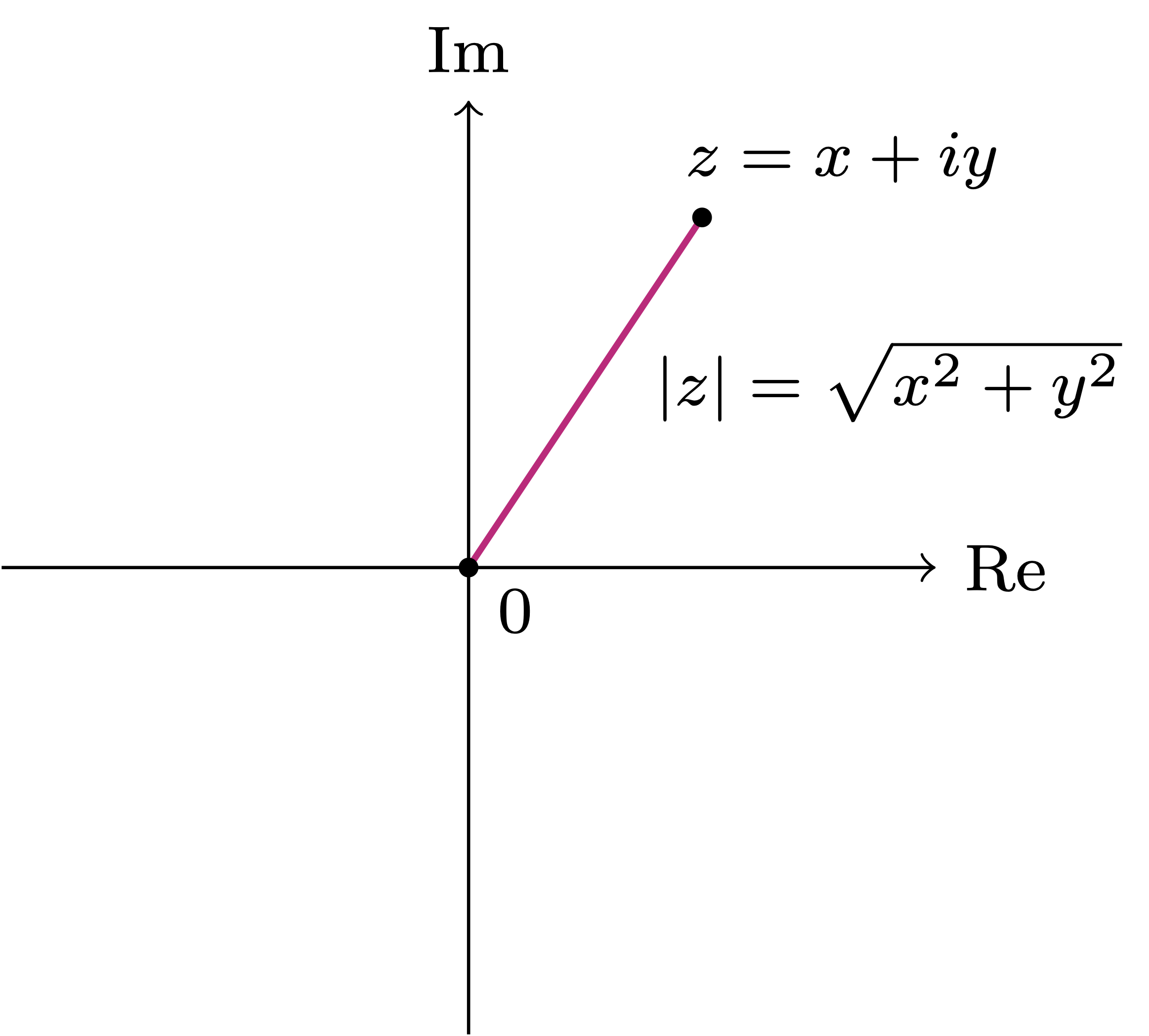
5.3.1 Distance on \(\mathbb{C}\)
The Cartesian representation allows us to introduce a distance between two complex numbers. Let us start with the distance between a complex number \(z=x+i y\) and \(0\). By Pythagoras Theorem this distance is given by \[ \sqrt{x^{2}+y^{2}} \,, \] see Figure 5.2. We give a name to this quantity.
Definition 21: Modulus
Note that the distance between \(z\) and \(0\) is always a non-negative number.
Remark 22: Modulus of Real numbers
We can now define the distance between two complex numbers.
Definition 23: Distance in \(\mathbb{C}\)
The geometric intuition of why the quantity \(|z_1 - z_2|\) is defined as the distance between \(z_1\) and \(z_2\) is given in Figure 5.3.
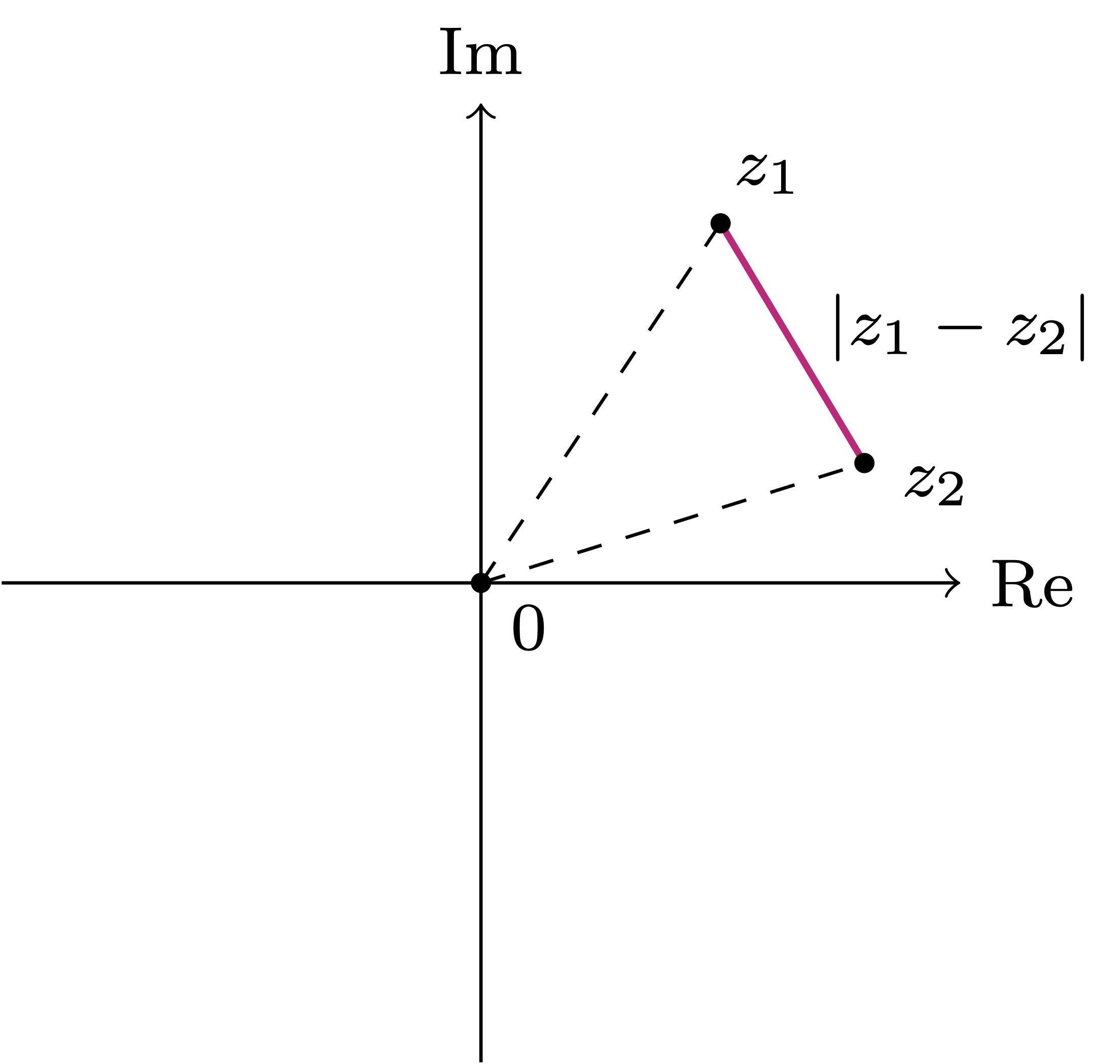
Theorem 24
Proof
Example 25
5.3.2 Properties of modulus
The modulus has the following properties.
Theorem 26
Let \(z, z_{1}, z_{2} \in \mathbb{C}\). Then
\(\left|z_1 \cdot z_2\right|=\left|z_{1}\right|\left|z_{2}\right|\)
\(\left|z^{n}\right|=|z|^{n}\) for all \(n \in \mathbb{N}\)
\(z \cdot \bar{z}=|z|^{2}\)
Proof
Part 2. Exercise. It easily follows from Point 1 and induction.
Part 3. Let \(z=x+ i y\) for some \(x, y \in \mathbb{R}\). Then,
\[\begin{align*} z \cdot \bar{z} & = (x+i y)(x- i y) \\ & = x^{2}-(i y )^{2} \\ & = x^{2}+y^{2} \\ & =|z|^{2} \end{align*}\]
The modulus in \(\mathbb{C}\) satisfies the triangle inequality.
Theorem 27: Triangle inequality in \(\mathbb{C}\)
For all \(x, y, z \in \mathbb{C}\),
\(|x+y| \leq|x|+|y|\)
\(|x-z| \leq|x-y|+|y-z|\)
Proof
This last statement is clearly true, since \(a d-b c \in \mathbb{R}\). Therefore (5.3) holds, and so (5.2) follows.
Part 2. Using (5.2) we estimate \[ |x-z|=|x-y+y-z| \leq|x-y|+|y-z| . \]
Remark 28: Geometric interpretation of triangle inequality
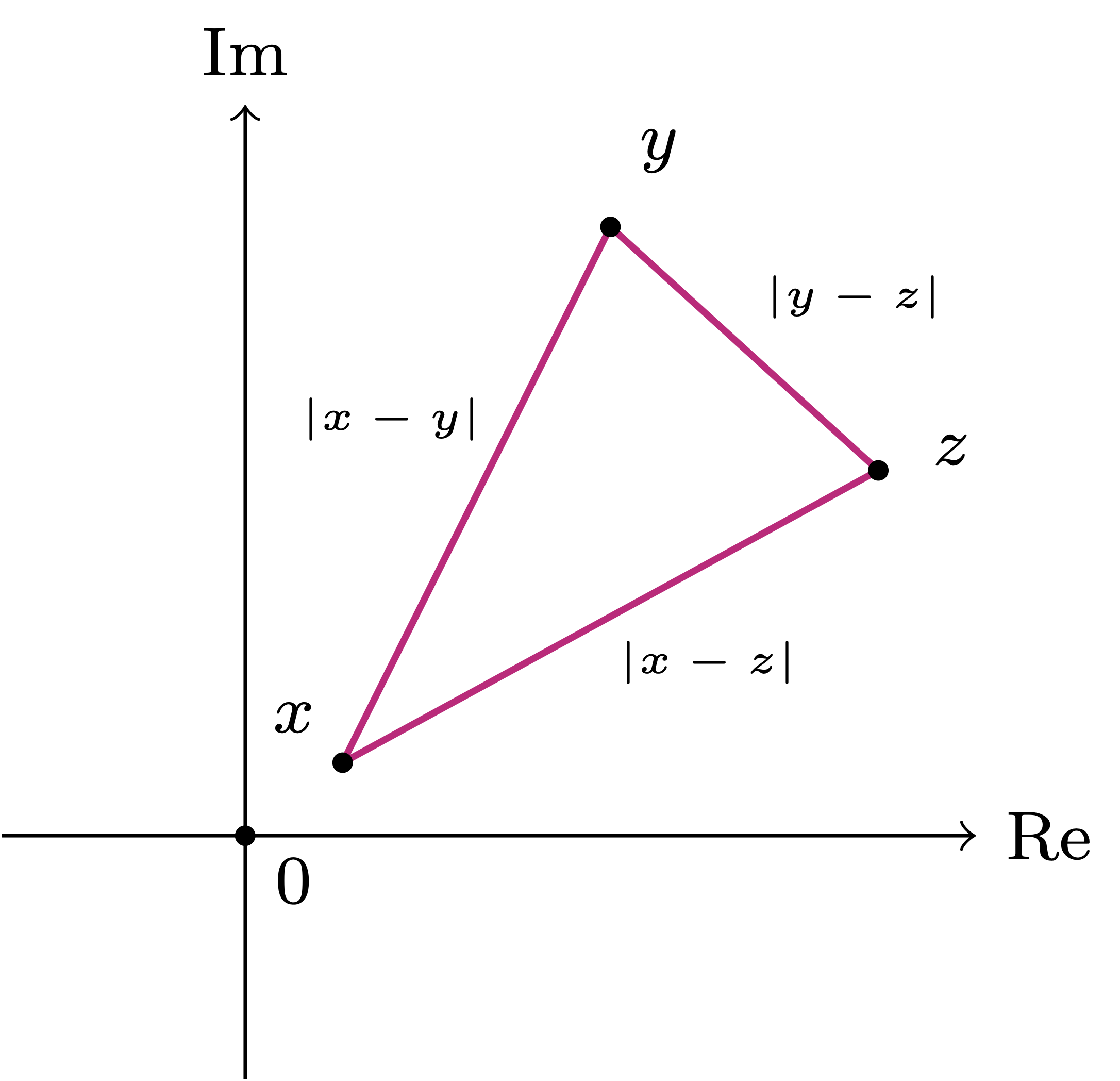
5.4 Polar coordinates
We have seen that we can identify a complex number \(z=x+iy\) by a point in the complex plane with Cartesian coordinates \((x, y)\). We can also specify the point \((x,y)\) by using the so-called polar coordinates \((\rho, \theta)\), where
\(\rho\) is the distance between \(z\) and the origin \[ \rho = |z| = \sqrt{x^2 + y^2} \]
\(\theta\) is the angle between the line connecting the origin and \(z\) and the positive real axis, see Figure 5.5.
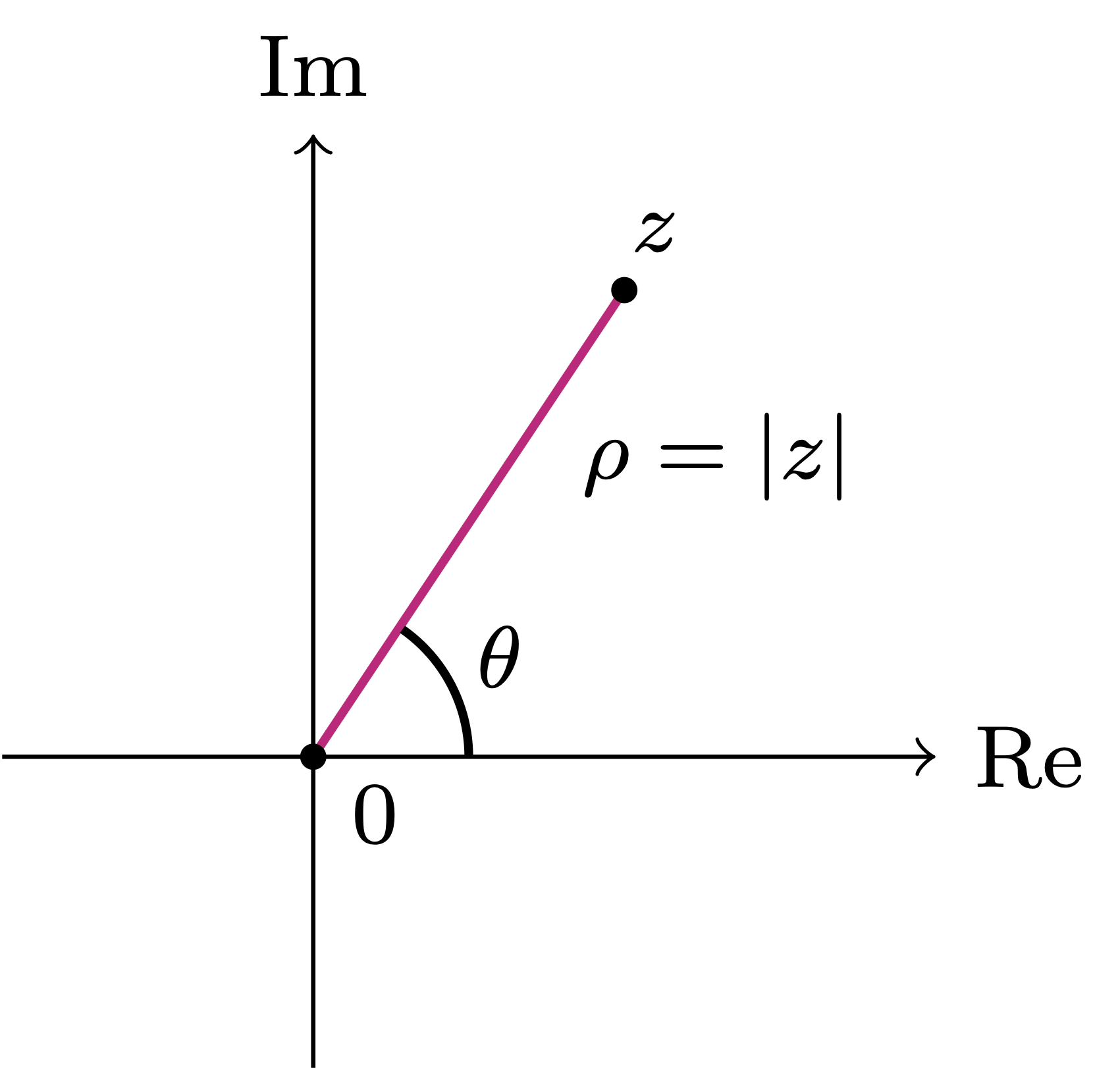
We give such angle a name.
Definition 29: Argument
Warning
Remark 30: Principal Value
Example 31
We can represent non-zero complex numbers in polar coordinates.
Theorem 32: Polar coordinates
The proof of Theorem 32 is trivial, and is based on basic trigonometry and definition of \(\arg(z)\). Complex numbers in polar form can be useful. We give a name to such polar form.
Definition 33: Trigonometric form
Let us make an example.
Example 34
As a consequence of Theorem 32 we obtain a formula for computing the argument.
Corollary 35: Computing \(\arg(z)\)
Proof
Example 36
5.5 Exponential form
We have seen that we can represent complex numbers in
- Cartesian form
- Trigonometric form
We now introduce a third way of representing complex numbers: the exponential form. For this, we need Euler’s identity:
Theorem 37: Euler’s identity
Proof
The above identities also holds for \(x \in \mathbb{C}\). Hence we can substitute \(x=i \theta\) in the series for \(e^{x}\) to obtain \[\begin{align*} e^{i \theta} & =1+i \theta+\frac{(i \theta)^{2}}{2 !}+\frac{(i \theta)^{3}}{3 !}+\frac{(i \theta)^{4}}{4 !}+\frac{(i \theta)^{5}}{5 !}+\frac{(i \theta)^{6}}{6 !}+\frac{(i \theta)^{7}}{7 !} \ldots \\ & =1+i \theta-\frac{\theta^{2}}{2 !}-i \frac{\theta^{3}}{3 !}+\frac{\theta^{4}}{4 !}+i \frac{\theta^{5}}{5 !}-\frac{\theta^{6}}{6 !}-i \frac{\theta^{7}}{7 !}+\ldots \\ & =\cos (\theta)+i \sin (\theta), \end{align*}\]
where we used that \(i^{2}=-1\) in the second equality, and the third equality follows by observing that all terms with an even power of \(\theta\) are exactly the terms in the expansion of \(\cos (\theta)\) and all terms with an odd power of \(\theta\) are exactly the terms in the expansion of \(\sin (\theta)\) multiplied by \(i\).
Theorem 38
Proof
Theorem 39
Definition 40: Exponential form
Example 41
Remark 42: Periodicity of exponential
For all \(k \in \mathbb{Z}\) we have \[ e^{i \theta}=e^{i(\theta+2 \pi k)} \,. \tag{5.5}\] As we did for the principal value of the argument, also for the exponential form we select \(\theta \in(-\pi, \pi]\). In particular equation (5.5) is saying that the complex exponential is \(2\pi\)-periodic.
Equation (5.5) follows immediately by Euler’s identity and periodicity of \(\cos\) and \(\sin\), since \[\begin{align*} e^{i(\theta+2 \pi k)} & = \cos(\theta+2 \pi k) + i \sin (\theta+2 \pi k) \\ & = \cos(\theta) + i \sin (\theta) = e^{i \theta} \,. \end{align*}\]
The exponential for is very useful for computing products and powers of complex numbers.
Proposition 43
The proof follows immediately by the properties of the exponential. Let us see some applications of Propostion 43.
Example 44
Using the exponential form simplifies this calculation. Indeed, we know that \[ -2+2 i = \sqrt{8} e^{i \frac{3}{4} \pi} \] by Example 41. Hence \[ (-2+2 i)^{4}=\left(\sqrt{8} e^{i \frac{3}{4} \pi}\right)^{4}=8^{2} e^{i 3 \pi}=-64 \,, \] where we used that \[ e^{i 3 \pi} = e^{i \pi} = \cos(\pi) + i \sin(\pi) = - 1 \] by \(2\pi\) periodicity of \(e^z\) and Euler’s identity.
Example 45
5.6 Fundamental Theorem of Algebra
We started the introduction to complex numbers with the following question:
Question 46
The answer is no. For this reason we introduced the complex number \(i\), which satisfies \[ i^{2}=-1 \,. \] Therefore (5.6) has solution in \(\mathbb{C}\), with \(x = i\). We also have that \[ (-i)^{2}=(-1)^{2} i^{2}=-1 \,. \] Hence (5.6) has two solutions in \(\mathbb{C}\), given by \[ x_1 = i \,, \quad x_2 = - i \,. \]
It turns out that the set \(\mathbb{C}\) is so large that we are not only able to solve (5.6), but in fact any polynomial equation.
Theorem 47: Fundamental theorem of algebra
Theorem 47 says that every polynomial of degree \(n\) has \(n\) zeros, sometimes also called roots, i.e., \(n\) solutions to (5.8). We call the expression (5.7) a factorization of the polynomial \(p_n\).
Several proofs of Theorem 47 exist in the literature, but they all use mathematical tools which are out of reach for now. Therefore we will not show a proof. For example one can prove Theorem 47 by
- Liouville’s theorem (complex analysis)
- Homotopy arguments (general topology)
- Fundamental Theorem of Galois Theory (algebra)
Example 48
Example 49
Let us find such solutions. We use the well known formula \[
a^2-b^2 = (a+b)(a-b) \,, \quad \forall \, a,b \in \mathbb{R}\,,
\] to factorize \(p\). We get: \[
p(x) = (x^4-1) = (x^2+1)(x^2-1) \,.
\] We know that \[
x^2 + 1 = 0
\] has solutions \(x = \pm i\). Instead
\[
x^2 - 1 = 0
\] has solutions \(x = \pm 1\). Hence, the four solutions of (5.10) are given by \(x=1,-1, i,-i\) and \[
p(x) = x^4 - 1 = (x-1)(x+1)(x-i)(x+i) \,.
\]
Definition 50
Example 51
The equation \[ (x-1)(x-2)^{2}(x+i)^{3}=0 \] has 6 solutions:
- \(x=1\) with multiplicity \(1\)
- \(x=2\) with multiplicity \(2\)
- \(x=-i\) with multiplicity \(3\)
5.7 Solving polynomial equations
The non-factorized version of the polynomial \[ p(x) = (x-1)(x-2)^{2}(x+i)^{3} \] from Example 51 is \[\begin{align*} p(x) = & x^{6}-(5-3 i) x^{5}+(5-15 i) x^{4} \\ & + (11+23 i) x^{3}-(24+7 i) x^{2}+(12-8 i) x+4 i \end{align*}\] We therefore have the following natural question.
Question 52
The answer is that there is no general way to solve (5.11) when \(n \geq 5\). This is the content of the Abel-Ruffini Theorem.
Theorem 53: Abel-Ruffini
Similarly to the Fundamental Theorem of Algebra, the proof of the Abel-Ruffini Theorem is out of reach for our current mathematical knowledge. A proof can be carried out, for example, using Galois Theory.
There are however explicit formulas for solving (5.11) when \(p_n\) has degree \(n=2,3,4\). For \(n=2\) we can use the well-known quadratic formula.
Proposition 54: Quadratic formula
- If \(\Delta > 0\) then (5.12) has two distinct real solutions given by \[ x_1 = \frac{-b - \sqrt{\Delta}}{2 a} \,, \quad x_2 = \frac{-b + \sqrt{\Delta}}{2 a} \,. \]
- If \(\Delta = 0\) then (5.12) has one solution with multiplicity \(2\). Such solution is given by \[ x_1 = \frac{-b}{2 a} \,. \]
- If \(\Delta < 0\) then (5.12) has two distinct complex solutions given by \[ x_1 = \frac{-b - i\sqrt{-\Delta}}{2 a} \,, \quad x_2 = \frac{-b + i\sqrt{-\Delta}}{2 a} \,, \] where \(\sqrt{-\Delta}\) is a real number, since \(-\Delta>0\).
Moreover, if \(\Delta \neq 0\) we have \[ a x^{2}+b x+c = a (x-x_1)(x-x_2) \,, \] while if \(\Delta = 0\) then \[ a x^{2}+b x+c = a (x-x_1)^2 \,. \]
Example 55
Example 56
Example 57
So far we have considered the polynomial equation \[ ax^2 + bx + c = 0 \,, \] for \(a,b,c \in \mathbb{R}\) and \(a \neq 0\).
Question 58
If \(a, b, c \in \mathbb{C}\) then we might have \[ \Delta := b^{2}-4 a c \in \mathbb{C}\,. \] Therefore it is not clear how to compute \[ \sqrt{\Delta} \,. \] However, we can still use the quadratic equation.
Proposition 59: Generalization of quadratci formula
Remark 60
- If \(\Delta>0\) there are two real solutions \[ S_1 = -\sqrt{\Delta} \,, \quad S_2 = \sqrt{\Delta} \]
- If \(\Delta = 0\) then \(0\) is the only solution with multiplicity \(2\). Hence \[ S_1 = S_2 = 0 \]
- If \(\Delta<0\) there are two complex solutions \[ S_1 = - i \sqrt{-\Delta} \,, \quad S_2 = i \sqrt{-\Delta} \]
Therefore the solutions \[ x_1 = \frac{-b + S_1}{2 a} \,, \quad x_2 = \frac{-b + S_2}{2 a} \,, \] given in Proposition 54 coincide with the ones given in Proposition 59.
Example 61
In the above example it was a bit laborious to compute \(S_{1}\) and \(S_{2}\). In the next section we will see an easier way to solve problems of the form \(z^2 = \Delta\).
Remark 62: Polynomial equations of order \(n=3,4\)
Still, it is sometimes possible to solve equations of degree higher than 2, in case it is obvious from inspection that a certain number is a solution, e.g., when \(x=-1,0,1\) is a solution.
Example 63
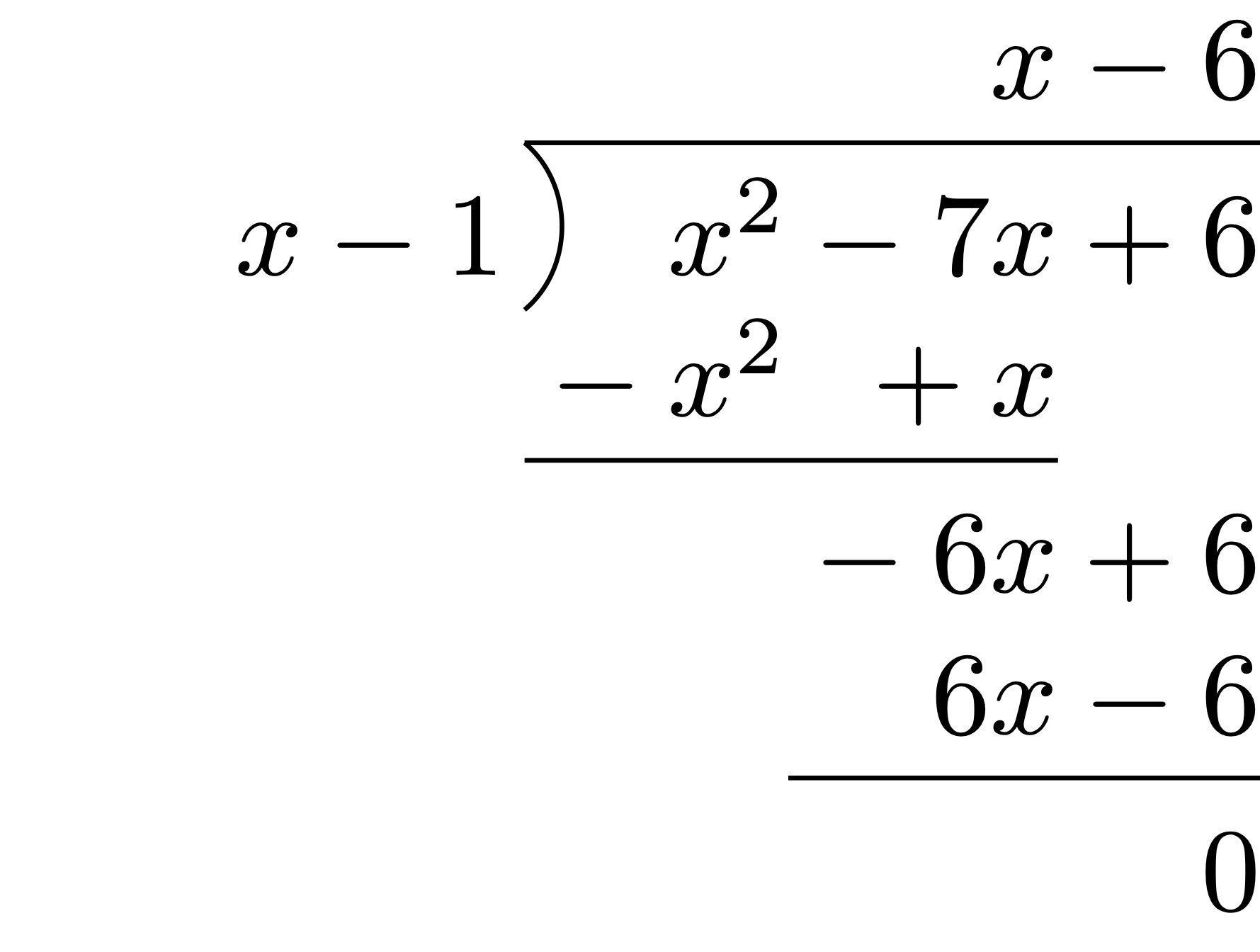
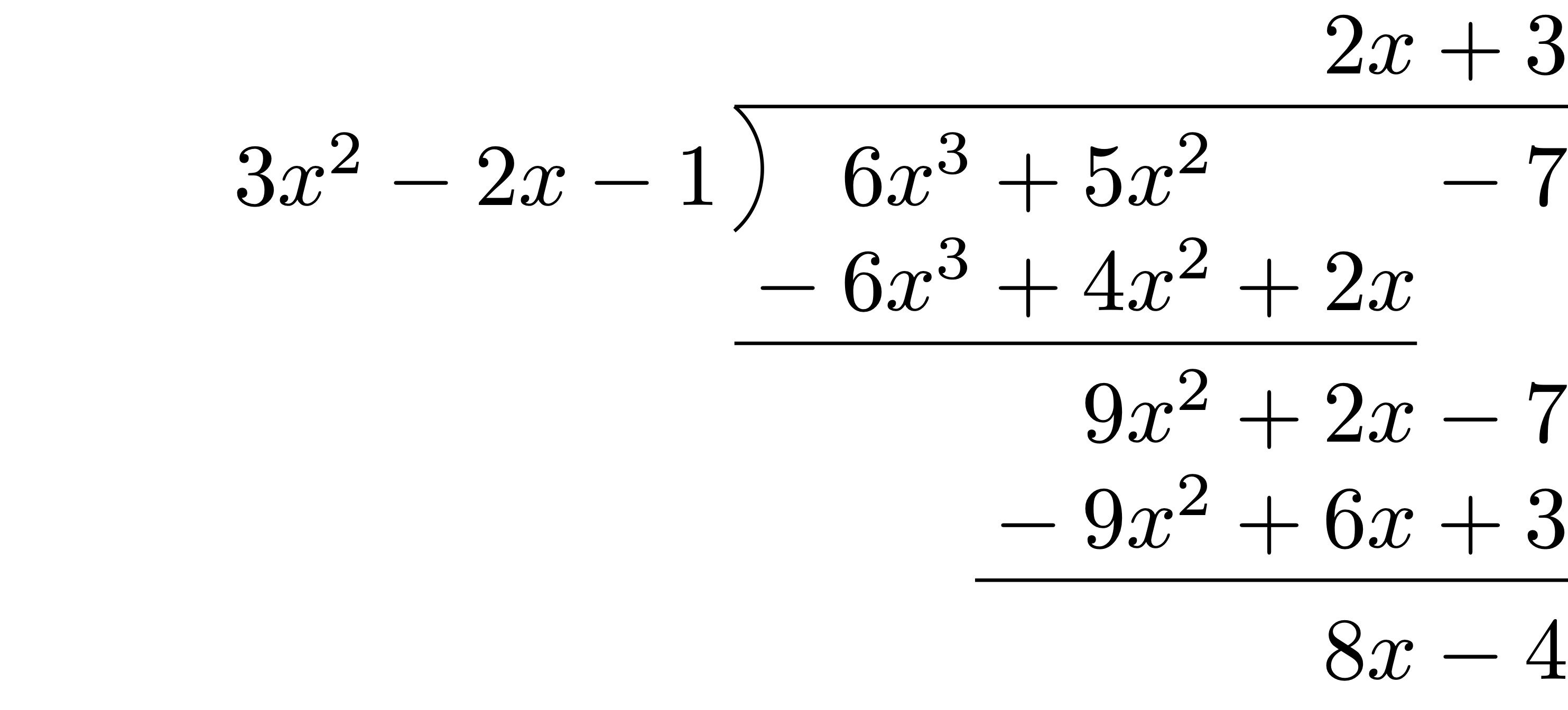
Example 64
\[ \frac{x^{3}-7 x+6}{x-1}=x^{2}+x-6 \,, \] see Figure 5.7. For the remaining two solutions, we can use the quadratic formula to obtain that also \(x=2\) and \(x=-3\) are solutions. Thus \[ x^{3}-7 x+6 = (x-1)(x-2)(x+3) \,. \]
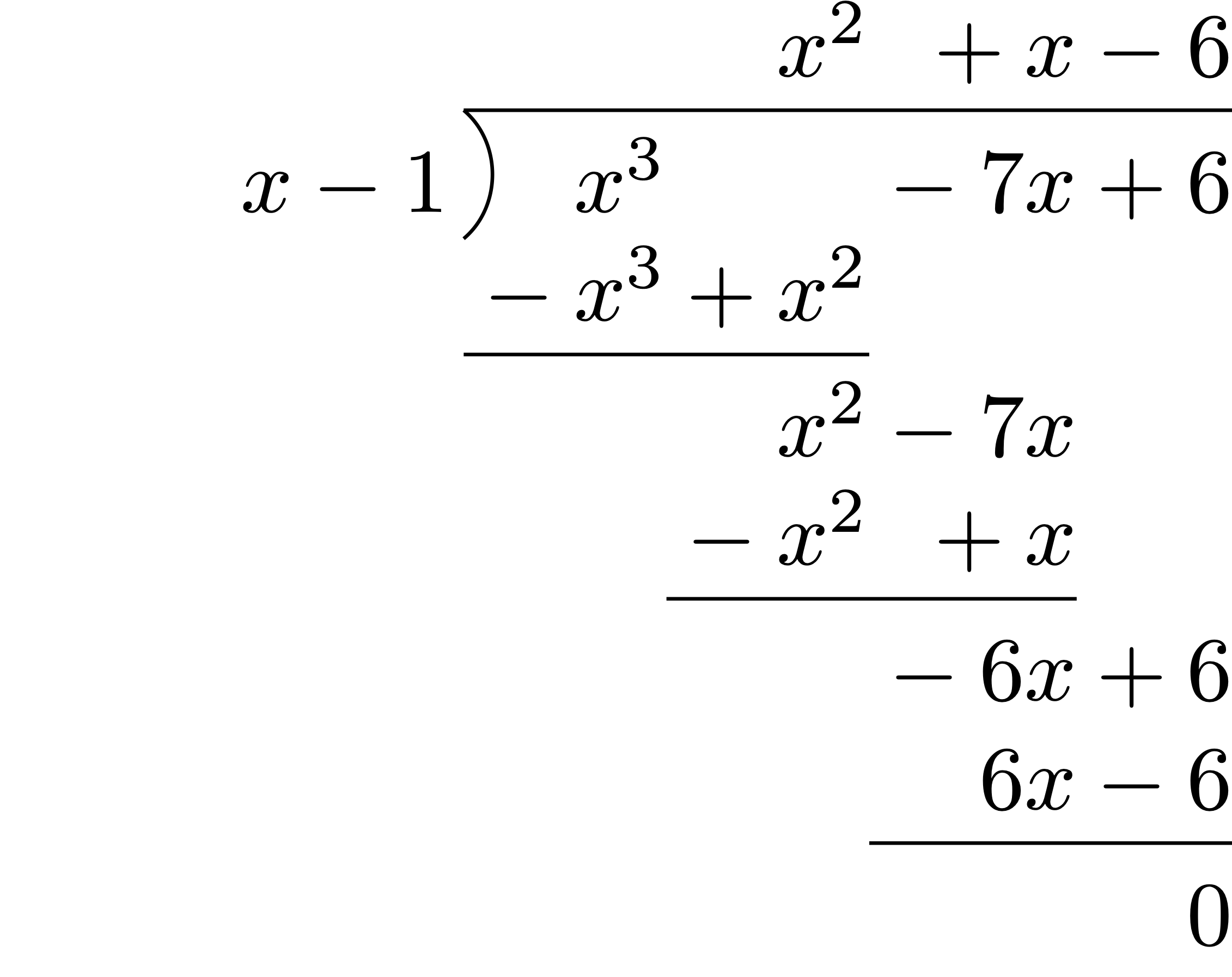
5.8 Roots of unity
Problem
Note that \(z=1\) is always a solution to (5.15) if \(n\) is even. In such case also \(z=-1\) is a solution. If we were only looking for solutions in \(\mathbb{R}\), these two would be the only solutions.
However, the Fundamental Theorem of Algebra, see Theorem 47, tells us that there are \(n\) complex solutions to (5.15).
Question 65
Example 66
The trick to find all \(n\) solutions to (5.15) is to use the exponential form.
Theorem 67
Proof
Definition 68
Example 69
Example 70
5.9 Roots in \(\mathbb{C}\)
Problem
The Fundamental Theorem of Algebra ensures that the above has \(n\) complex solutions. To find these solutions, we pass to the exponential form.
Theorem 71
Proof
Example 72
By taking \(k=0,1,2,3,4\) we get the solutions \[\begin{align*} z_0 & = 2 e^{i \frac{\pi}{5}} \, & \quad & z_1 = 2 e^{i \frac{3 \pi}{5}} \\ z_2 & = 2 e^{i \pi}=-2 \, & \quad & z_3=2 e^{i \frac{7 \pi}{5}} \\ z_4 &= 2 e^{i \frac{9 \pi}{5}} & \quad & \end{align*}\]